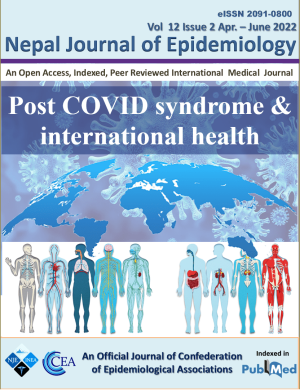Post COVID syndrome: A novel challenge and threat to international health
DOI:
https://doi.org/10.3126/nje.v12i2.46149Keywords:
Post-acute COVID-19 syndrome, COVID-19 post-intensive care syndrome, COVID-19, Coronavirus InfectionsAbstract
The global pandemic caused by the SARS-CoV-2 virus has affected every continent worldwide. The novelty of this virus, its mutations and the rapid speed and unprecedented rate at which it has torn through the global community has in turn lead to an innate lack of knowledge and information about the actual disease caused and the severity of the complications associated with COVID-19. The SARS-CoV-2 virus has been infecting individuals since 2019 and now as of 2022 has been circulating for just over 2 years within the global populous. As the number of cases have risen globally over this period (some of which having contracted the virus twice) further endeavours have been undertaken to better understand the pathogenesis and natural progression of the disease. A condition reported in some cases with extended bouts of sickness or symptoms following the initial infection with COVID was labelled “long COVID” towards the earlier phases of the pandemic (in the spring of 2020), but has only recently gained the global media and medical attention due to its affliction of more individuals on a global basis and has thus warranted further investigation. Long COVID is described as a persistent, long-term state of poor health following an infection with COVID-19. The effect of Long COVID is multisystemic in nature with a wide array of signs and symptoms. The most commonly reported clinical features of long COVID are: headaches, myalgia, chest pain, rashes, abdominal pain, shortness of breath, palpitations, anosmia, persistent cough, brain fogs, forgetfulness, depression, insomnia, fatigue and anxiety. This research aims to explore the symptomatology, pathophysiology as well as the treatment and prevention of Long COVID.
Downloads
Downloads
Published
How to Cite
Issue
Section
License
Copyright (c) 2022 CEA & INEA

This work is licensed under a Creative Commons Attribution 4.0 International License.
- Upon acceptance Copyright on any research article is transferred in full to the Confederation of Epidemiological Associations (CEA) and International Nepal Epidemiological Association (INEA). The copyright transfer includes the right to reproduce and distribute the article in any form of reproduction (printing, electronic media or any other form).
- Articles in the Nepal Journal of Epidemiology are Open Access articles published under the Creative Commons CC BY License (https://creativecommons.org/licenses/by/4.0/)
- This license permits use, distribution and reproduction in any medium, provided the original work is properly cited.




